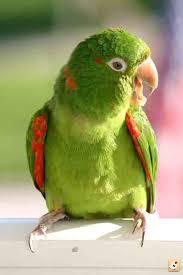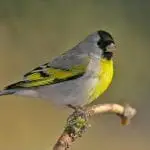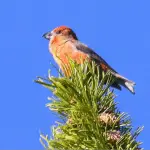Scientific Facts
| Common Name: | White-eyed conure, white-eyed parakeet |
| Scientific Name: | Psittacara leucophthalmus |
| Life Span: | 25 to 30 years |
| Size: | 12.5 inches |
| Habitat: | Mangroves, savannas, woodlands, and forests |
| Country of Origin: | Northern South America |
Physical Description

The white-eyed conure is a tiny green parrot, which is one of the better-behaved species of conure. It is less noisy compared to other parrots. This bird is also non-destructive and may likely talk instead of scream.
On average, the white-eyed conure is 32 centimeters or 12.5 inches long. Its wing length measures between 166 to 188 mm or 6.5 to 7.5 inches. The conure is green and is slightly paler on the abdomen and breast with red on the shoulders and random red speckles on the neck and head.
Some red feathers are spread through the edge and bend of the wings, and even under the wing-coverts or feathers. The underwing primary wing coverts are in red tipped with yellow. The wing’s underside, including the feathers on the tail, are olive-yellow.
The irises of the white-eyed conure are brown, its feet are greyish, while the beak is horn-colored. A young white-eyed conure has little to no yellow and red in its feathers and dark irises.
Colors and Markings

The adult white-eyed conure is mostly in green with red patches on its wings and head. The interiors of its wings show bright yellow feathers tipped with red spread all over. This conure is sometimes in pure green until its wings are open, showing the flashes of red and yellow.
The eyes have white rings made of skin from which its common name came from. The white-eyed conure looks good with its horn-colored beak that complements those greyish legs and feet. Its subspecies originating in Ecuador has a bit darker plumage with a bigger and heavier beak.
History and Origin
The white-eyed conure is native to northern South America. Its range stretches from Colombia, Venezuela, and Guianas in the north down across Brazil to Uruguay and northern Argentina. Its preferred habitats are woodland areas, forests, mangroves, and savannas.
In 1776, the bird was cataloged and described by a zoologist from Germany named Phillipp Ludwig Muller. Its taxonomical name came from the ancient Greek words, opthalmus and leukos.
The population of white-eyed conure stays abundant in the woods, although it’s significantly trafficked in the commercial pet trade. As of now, it is the least concern species.
Habitat
The habitat of a white-eyed conure can be forests, savannas, woodlands, and mangroves. The breeding period in Argentina stretches from November up to December, including the northern portion of South America from February until June. This conure usually makes its nest in tall palm trees. However, this bird has been occasionally seen nesting underneath the roofs and other cavities in the urban areas.
Life Span
The lifespan of white-eyed conure depends a lot on the husbandry and its diet. Typically, this bird can last for 25 to as much as 30 years. This makes the white-eyed conure a suitable pet for those who are after long-term commitments.
Personality
The white-eyed conure is a great talking bird compared to other conures out there. The well-tamed conure can be so loving and sweet to its owner. It is rarely destructive. It does not love to scream as it prefers to mimic the words you say instead. Personality varies from one bird to another. However, this bird is usually known to be so inquisitive and playful. As with other conure species, it can get so loud in some cases. Some can be louder and noisier than others. However, it depends on training and personality.
Temperament
A properly tamed white-eyed conure can become a loving, entertaining pet. Though it’s not a noisier parrot, anyone who wants to own a conure must keep in mind that not all conures have powerful and loud voices if they like to use them. Due to this, the white-eyed conure might not make good pets for people who are living in the condominiums or apartments with adjacent neighbors.
The white-eyed conure is extremely intelligent. It requires sufficient mental stimulation to avoid behavioral problems and boredom. Anybody who likes to own a white-eyed conure must ensure he can spare 3-4 hours daily to interact with its pet. When left bored, the animal may become lethargic. It may show a destructive habit like feather plucking.
Breeding and Reproduction
In North America, this bird usually begins to breed in March or April while it happens in November or December in Argentina. In the northern part of South America, the white-eyed conure breeds from February to June. This bird often makes a nest in the palm trees. On average, the clutch consists of 3-4 eggs. The egg measures 1.22 by 0.98 inches.
The white-eyed conure is an active, slightly noisy to noisy parrot. It loves to be with people. When someone walks in, this bird will greet that person with a loud screech. It gets hardy once acclimatized. It is a very hard chewer and requires a consistent supply of fresh branches. It enjoys bathing.
Likewise, the white-eyed conure needs spacious flights that must be at least 9 x 3 x 6 feet with a sheltered spot. Also, this species requires protection against frost. The cage must have a roosting box that will also work as the nesting box when the bird gets into the breeding period.
Breeders out there say a lot of good things about this conure. They say it has excellent parenting skills, but this bird is seldom kept as a pet. It often begins to breed after many years. When it begins to breed, the bird may be somewhat prolific.
Under the ideal climate condition, it might even breed across the year and produce a maximum of 6 clutches. However, this bird often breeds twice a year. Double-clutching can happen only if you pull the previous clutch for hand-rearing.
Breeders prepare a nest box that measures 25 x 25 x 60 centimeters. On average, the size of the clutch is 3-4 eggs that will be incubated for up to 23 days. The hatchlings will fledge in the next 50 days.
Sometimes, a young white-eyed conure begins to talk when it is weaned. In general, it ill talk when it is already 6 months old. Breeding requisites for the white-eyed conure is much the same for other conures.
Where to Get One?
If you want to take care of a white-eyed conure, then you may get your pet from a local or online pet store. Also, you may easily get it from a professional breeder who is specializing in conures. No matter where you choose to get your pet from, make sure it’s a healthy and active bird. Check the bird carefully before purchasing it.
How to Care for a White-Eyed Conure?
A white-eyed conure is a striking bird that makes good pets for those who are serious in taking care of small but terrible birds. This species is so intelligent and curious. It loves exploration. Likewise, it is so susceptible to getting involved in problems as it can mess with things if you leave it unattended.
When properly tamed and cared for, however, people who keep a white-eyed conure say this bird is so entertaining and affectionate.
One bird requires a cage that is of the right size. For footprint, the cage must be 24 x 24 inches. For the height, the cage must be 36 inches or higher. After getting the right cage for your pet, add some sturdy toys and perches that will make the bird happier inside.
When you take it out of the cage, the bird should have a playpen in which it can explore or exercise while it flies all over your house. In the forest, this bird flies and reaches a long distance as it goes with other birds. Hence, it requires space and the opportunity to reach that natural instinct in captivity.
Diet and Feeding
Its natural diet includes fruits like berries, seeds, vegetables, flowers, and nuts. It can also eat insects along with their larvae. Its captive diet must consist of a dry mix, which includes the seeds of sunflower and safflower, oats, buckwheat, hemp, rowan berries, and canary seed. Its seeds must be in the sprouted form.
You can feed your pet with more veggies, fruits, and greens. You can also feed it with fresh branches of plants with buds or flowers. These are healthy and will be good for your pet’s favorite activity – chewing. Dried shrimp and egg food are important throughout the breeding period. You can also give a vitamin and mineral supplement if you think that will be necessary.
Like other parrots, the white-eyed conure feels better if its diet consists of fresh vegetables and fruits and supplemented with a quality pelleted diet. You can also offer a handful of seeds as treats. Just make sure that your pet is not getting a lot of seeds in its daily meals.
Keep in mind that the white-eyed conure is more likely to become addicted to the fattening seeds like safflower and sunflower. If you give more than the acceptable amount, the bird may eventually refuse to take other foods. Always check your pet’s diet to make sure it stays happy and healthy.
You can also give freshly cut plant branches with buds or flowers. This will give the extra nutrients that your white-eyed conure needs. Also, it will satisfy your bird’s urge to gnaw and chew.
Exercise
People who own a white-eyed conure should ensure the bird has a secure birdproof area outside of the cage where it can also play or stretch its wings every day. More time will be better, but this bird requires at least 3-4 hours of monitored out-of-the-cage playtime each day. It’s a major commitment that may last for twenty years or longer. Thus, it is so important to do comprehensive research before you buy a white-eyed conure and keep it as a pet.
Common Health Problems of a White-Eyed Conure
This bird has been found prone to conure bleeding syndrome. The symptoms of this condition are loss of balance, weakness, and bleeding from its mouth. Conure bleeding syndrome often takes place in stressed birds.
A young white-eyed conure is more susceptible to this condition than an adult. The best way to prevent this condition is to give supplements to your pet and feeding it with leafy greens. This will be enough in getting the necessary vitamin K to stay healthy and less susceptible to this syndrome.
Feather plucking can take place in a bored bird because of inadequate stimulation. You can prevent it by spending more time playing and petting the bird.
Housing
The best cage for a white-eyed conure is an aviary or a suspended enclosure. It must be at least 9.8 long. Aside from providing the right kind of cage, your pet will also need a water bowl that is big enough so that the bird can plunge into the water and bathe whenever it wants to.
Also, the cage should have a ladder, rope, puzzle or foraging toys veggie-tanned chew toys, bird-safe toys made of wood, willow and pine branches or perches, and heat-sterilized pine cones.
FAQs
Is a white-eyed conure hard to take care of?
Every conure is playful, loud, and active. It tends to be curious instead of being shy and nervous, but taking care of a conure is always a happy and rewarding experience for anyone.
Does the white-eyed conure like being held?
The white-eyed conure will always long for your loving hands and time. It requires at least 3 hours each day playing with you and resting on your shoulders if you are so busy.
Is a white-eyed conure affectionate?
Conures are known to be so loving and entertaining. The white-eyed conure enjoys petting and hours of handling and play.
Is a white-eyed conure loud and noisy?
Compared to other conures, a white-eyed conure stays calm and a little talkative. It will not greet you with a scream whenever it sees you but will try to mimic every word you say.
Can a white-eyed conure talk?
A white-eyed conure can also good at speaking. With proper training, it will be able to repeat those words it often hears from you.



